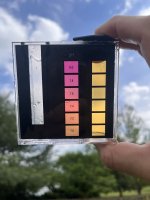tikoh
Bronze Supporter
What has your TA historically been at? At very low pH (around 6ish), carbonic acid will actually show up as alkalinity. As the name would suggest, this is an acid and gives you low pH while also showing up as high alkalinity. There was an article by chem geek from a long time ago that explained this, but I can't seem to find it.ok, I will recheck them both. I am pretty sure I'm testing both properly as I have watched the Taylor videos on youtube several times.
You can read about the carbonate system here: https://water.mecc.edu/courses/Env211/lesson7_4b.htm and if I find chemgeeks article relating it to pools I'll post it. Essentially, alkalinity is the capacity of a solution to resist a reduction in pH. At very high pH (like 11+), hydroxide ion [OH–] concentration is so high that it takes a significant amount of acid to neutralize enough of them before the pH drops. At very low pH, hydronium ion [H+] (which is actually acid) concentrations are very high, and as a result, a much higher concentration of acid is required to further lower the pH. Think about it this way, the more acidic you are, the harder it is to get more acidic. In between we mostly think of carbonates (CO3) as our alkalinity. At normal pool pH, it is bicarbonate (HCO3-). At around pH 6, that bicarbonate takes on a [H+] and becomes carbonic acid (H2CO3).
The TA test is a titration with a standard acid to a designated pH. The more drops it takes to get there, the more resistance the water sample has to a reduction in pH. When you're in a normal pool pH range, the acid eats up that HCO3-, drops the pH, and the color changes. However, when you're not in the normal pH range, the standard acid (sulfuric in most Taylor kits) doesn't react as readily with the carbonic acid and it actually takes more drops to get a change.
In any case, you have two options, and the best answer might be to do both... The first step is to aerate. Do it by whatever method works best for you, but do it like crazy. The other thing you can do is to use borax to raise pH while not significantly adding TA.
Of course, this is all assuming that your pH reading is correct, so I would also follow James' advice and try new reagents. You can get the phenol red pH test anywhere.


